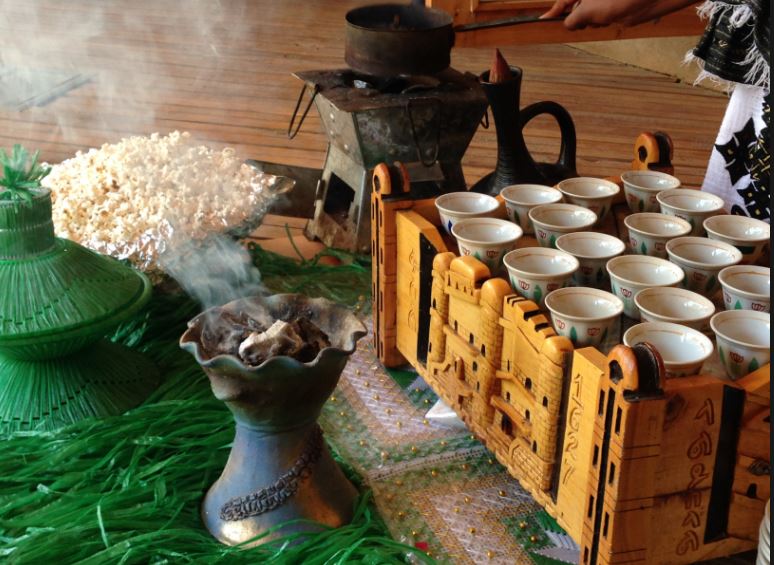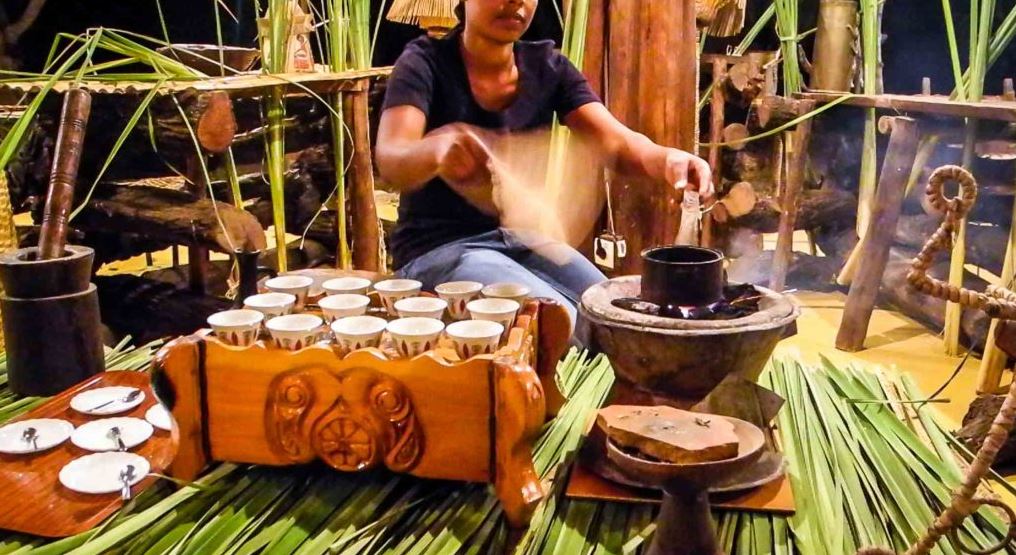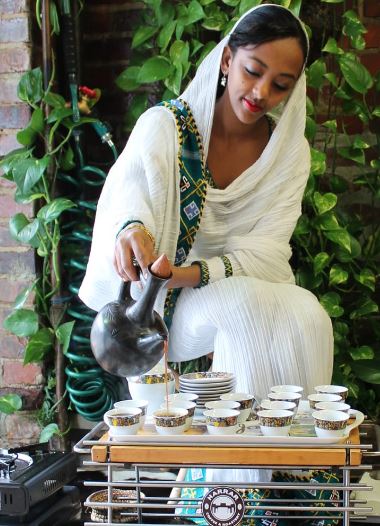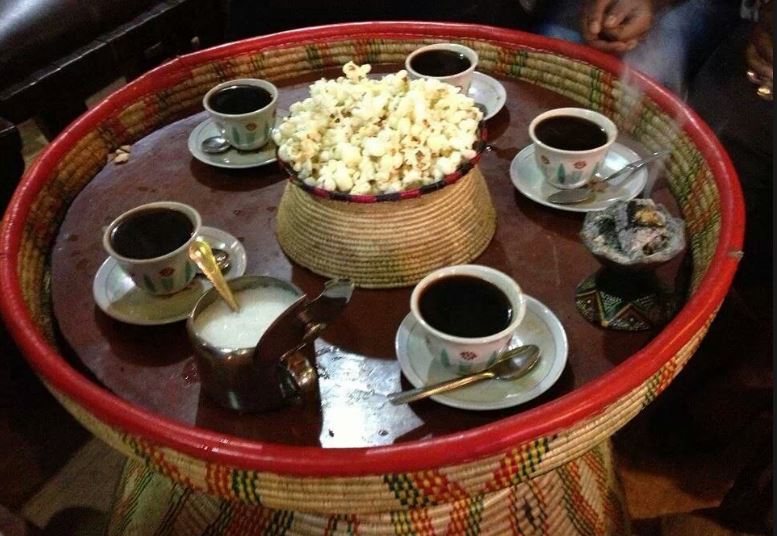Ethiopian Coffee Ceremony
It is undisputed that Ethiopia is the homeland of coffee. However, there are a variety of legends about how the coffee was discovered there. The most widespread is that mankind owes the discovery of coffee to the strange behavior of Ethiopian mountain goats: more than a thousand years ago, shepherds in the Abyssinian highlands of the Kaffa region were reported to have lost their goats at night, and they with her muggy for the sleep brought. They sought advice from the monks in the nearby monastery, who found that where the herd was grazing there were tree-like shrubs with cherry-like green, yellow and red fruits. They tasted the fruits and also got into high spirits. Nobody wants to summon the truth of this story,
In any case, the preparation of coffee in its most beautiful form has been developed in Ethiopia. Because coffee is a national drink, incidentally the only important export commodity that Ethiopia possesses, and an integral part of everyday life, both in the city and in the countryside, in the north, south, east and west.
The preparation is a woman’s thing, men drink with, but they have no idea about the coffee ceremony. The day is greeted right after getting up with the first coffee ceremony, which allows the wife of the house an almost meditative calm, before being released into the diligence and hardships of her everyday life. Once you have walked through the streets of Addis Ababa or one of the many small towns in the countryside at dawn, the delicious scent of freshly roasted coffee beans will always remain in his memory.
In addition, the coffee ceremony is an important symbol of hospitality. Whenever a visitor comes into the house, a coffee ceremony is performed. Not to offer coffee to a guest, but vice versa, as a guest to refuse a coffee, is considered rude. In addition, the coffee ceremony has an important social significance, especially in women’s lives. If there is any conflict between neighbors or between friends or colleagues, the disagreement at a coffee ceremony is discussed and dispelled. During a coffee ceremony people talk as openly as on any other occasion. Mostly successful; because it is rare for a coffee to develop a form of understanding. So the coffee ceremony is not just an everyday tradition,
The raw materials for the coffee ceremony are the green coffee beans that have already been freed from their red peel. So the coffee farmer delivers it to the dealer. The raw coffee beans are first washed in water and then rubbed dry with a soft cloth or bare hands. The beans cleaned in this way are stored in a domed dish made of sheet metal or iron.
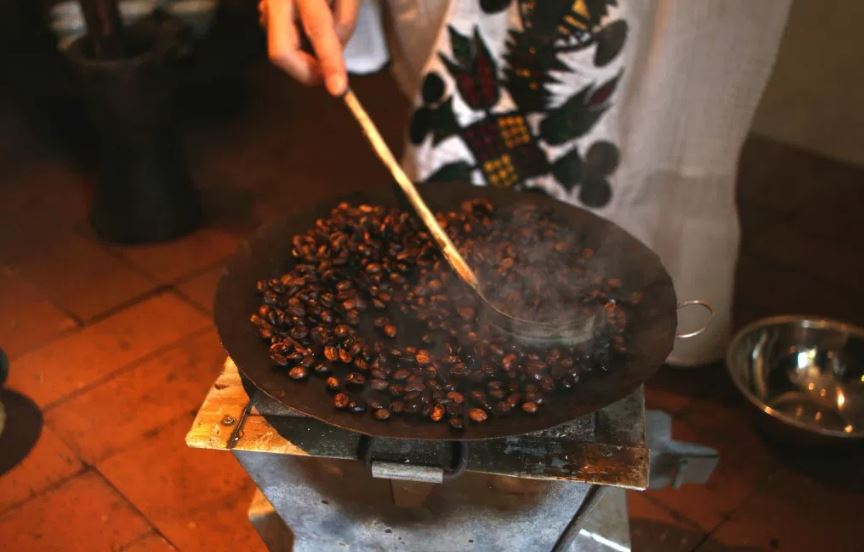
Next is roasting, with the shell serving as a pan. She is placed on the tin stove full of glowing charcoal, in front of which the hostess, usually the housewife or a daughter, sometimes a domestic worker, sits on a wooden stool. Around her, she spread fresh grasses on the ground, bought in bundles at the market. The grass on the ground symbolizes the connection of the inhabitants with nature. And the wish that it always stays green.
The women put the Netala, the traditional scarf made of the finest cotton, around their heads and shoulders and devote themselves to the cause. With a small straw fan, the flames in the small oven air zugewedelt. The green coffee beans are now pushed back and forth with an iron hook on the hot sheet metal backing until they have reached the correct shade of dark. Patience is needed here as it takes time for the beans to roast properly.
Meanwhile, a delicious fragrance spreads throughout the room. When the roasting process is complete, the bowl of hot coffee beans is handed out by the hostess so everyone can absorb the scent. Then the hot coffee beans are placed in a wooden mortar and pounded rhythmically with a pestle to fine coffee powder. At the same time, the water is boiled on a stove in a Jebanna, the Ethiopian coffee pot. The Jebanna is a bulbous clay pot with a narrow, raised, open-topped neck and a long beak. Once the water boils, the coffee powder is added with a spoon in the opening of the can neck.
Depending on the habit, the first coffee is boiled once or three times until the brew has the right strength. During this time, a few bits of red-hot charcoal are placed on a jar-shaped open clay pot and on top of that a few small pieces of incense, which now develop their incomparable scent. This emphasizes the solemnity of the coffee ceremony. Through the room now draws the very special aroma mixture of roasted coffee, charcoal and frankincense, to the steam of the simmering water – a sensual pleasure. Lastly, popcorn or collo, a mixture of crushed barley grains and dried chickpeas, is roasted on the charcoal. In some parts of Ethiopia, women cook spices with them. These may be cardamom kernels or cloves. Also a pinch of salt.
The small, handleless mocha cases, often with pretty paintings, standing on a wooden tray, are now washed out again with hot water, then a good portion of sugar is added, at least two small heaped spoons. Now comes the moment when the Jebanna coffee is poured, from a height of about 20 centimeters, but above all with a pour into all the cups until the last one is filled. While everyone enjoys sipping their coffee, the host cooks the second brew. Three cups are mandatory at the Ethiopian coffee ceremony – and each has its own special meaning. The first cup, the strongest, serves pure enjoyment. During the second cup the acute problems are discussed. Finally, the third and final cup serves the blessing of those present. Each cup is served with popcorn or collo.
The essence of a coffee ceremony is far from the pure enjoyment of coffee, but the act of coming together and talking to each other. For hours, the scent of coffee runs through the house, which is the epitome of security and community

